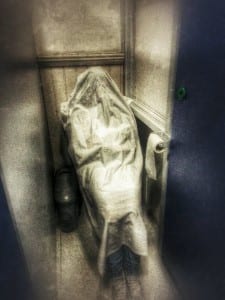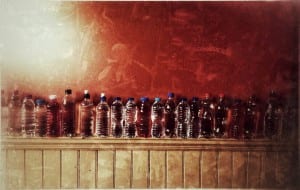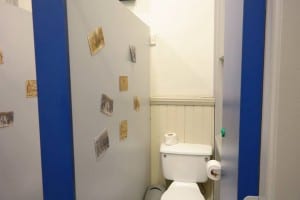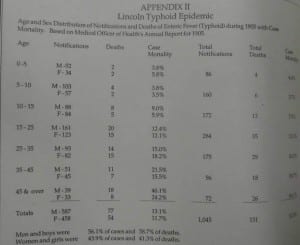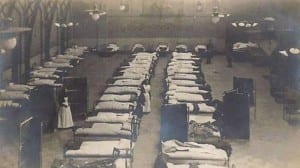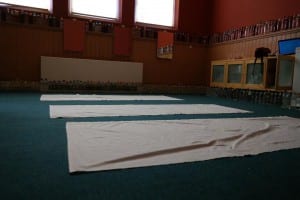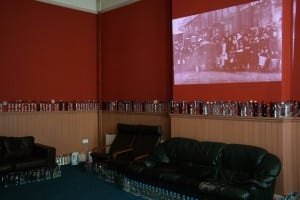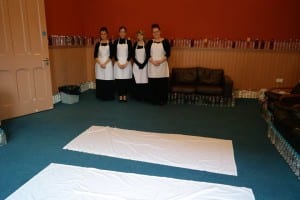Framing Statement
The Final Countdown was performed at the Drill Hall Theatre on the 8th of May 2015. This was a highly significant date as it was only four days before the 110 year anniversary of the last reported case of typhoid in Lincoln. The piece aimed to explore the stories behind the typhoid epidemic and enlighten the audience about the history of the Drill Hall. Our piece relied on cooperation with the audience to be fully involved in the piece as there was a great amount of audience interaction. According to Emma Govan, “within contemporary performance, site-related work has become an established practice where an artist’s intervention offers spectators new perspectives upon a particular site or set of sites” (Govan et al, 2007, 121). Therefore, throughout our performance we aimed to offer audiences a new perspective on the Drill Hall and wanted to educate them about the history of the theatre as well as sharing the story of the typhoid epidemic with them.
The Drill Hall is somewhat unexplored by the people of Lincoln, as they see it as a thriving theatre that has been established since the late twentieth century. Therefore, my group and I wanted to explore the history of the Drill Hall and showcase our research in a performance, which became what was our final piece The Final Countdown that aimed to inform Lincoln residents about the typhoid epidemic that broke out in 1904.
Within our site-specific performance, we chose to educate the audience on the history of the typhoid epidemic. Therefore, water became a main element in which we focused on in our piece. We created an installation with water bottles that were displayed around the room in which we performed. After researching at the archives we noted that there were 1045 people in the Lincoln area that were affected by the typhoid epidemic and out of those 131 cases were fatal. Therefore, the installation we created consisted of 1045 bottles placed around the room, with the 131 bottles filled with red food dye to symbolise the individuals that had fatal cases of the disease. The bottles acted as a visual aid for the audience to understand the depth in which the disease affected Lincoln. However, for the most part of the performance the audience were instructed to close their eyes. Therefore, the performance became one that relied on the audience’s senses and willingness to rely us as performers.
You Me Bum Bum Train (2004) became an influential company that were essential to the development to our piece, as we chose to have the audience members involved in the performance. They were not merely watching the performance but became participants who ‘acted’ as patients and entered into a sensory journey with the performers. For performers and participants a performance is an experience of “spatial, physical and emotional- preserved in the bodies and memories of the varying orders of participants: touch, proximity, texture […] But also as a series of physical, sensual and extra daily experiences” (Pearson and Shanks, 2001, 54). Therefore, within our piece we wanted to have interaction with participants and develop a performance space, whereby the patients experienced the disease without visual aid therefore relying entirely on their sensors.
The Final Countdown lasted a total of fifteen minutes, with three audience’s members being involved in each performance. Whilst audience members were informed about the personal stories of individuals who were affected by the typhoid epidemic; they also experienced the symptoms of the disease in an interactive style. Each participant was led into a toilet cubical totally reliant on guidance from the performer, then they all experienced a vocal and sensory experience as we vocalised the symptoms of each week of the typhoid disease. The performance ended with the patients being left in the toilet cubical by the performers. This gave them the opportunity to process the information that they had been given and think about the individuals that were affected.
Analyse of Process
Alison Oddey states that “any definition of devised theatre must include process (finding the ways and means to share an artistic journey” (Oddey, 1994, 3). Process is an essential element when creating theatre, without it a piece would be unable to develop and progress from an initial stimulus. The Drill Hall became our initial stimulus and after researching into the history of the theatre, it became apparent that this was an essential step within our process of the creation of The Final Countdown.
During our first experience at the Drill Hall we were informed about what the space had been previously used for throughout its history. Although the space is now an area for theatre to be explored and individuals entertained this was not always the case. Throughout the twentieth century the Drill Hall was used for a range of different reasons which included being used as a bingo hall, roller-skates disco, military training and finally in 1904 became the place where all the individuals who were affected by the typhoid epidemic went to be treated.
It became apparent that the typhoid epidemic was part of the Drill Hall’s history that had not been explored with a great amount of appreciation, as employees of the theatre were unaware of the part the Drill Hall played when the epidemic hit Lincoln. Therefore, our group decided that exploring the ‘lost history’ of the Drill Hall was a notion that we all found interesting. We wanted to inform the local people of Lincoln about their history that had not been explored in a dramatically way before.
After visiting the archives we soon realised that there was little research that had been kept from the typhoid epidemic. However, we soon realised that the number of individuals affected were 1045 and the amount of fatal cases were 131. Whilst exploring the archives we also found pictures and personal stories that were actually used within our final piece and gave us inspiration for the type of atmosphere we wanted to create.
Initially, we wanted to explore the auditorium as a space in which we could represent the out break of the typhoid epidemic, whilst educating the people of Lincoln about the history of the Drill Hall. We discovered that the auditorium was used as a hospital to care for those affected by the disease. However, it soon became apparent that the space wasn’t ideal for the atmosphere we hoped to create. The auditorium would have been overcrowded with beds of the sick and individuals would have felt claustrophobic. This is the type of atmosphere we wanted to reflect, and doing so in the auditorium would have been difficult as it is such a large space to try to create a confined, overcrowded atmosphere.
One of the first tasks we were given at the Drill Hall involved finding spaces that we had to fill our bodies with. This task was particularly interesting as it made me look beyond what was in our line of sight and delve into the hidden parts of the architecture within the Drill Hall. Also, it was important to explore, as when creating site-specific performances “a large part of the work has to do with researching a place, often an unusual one that is imbued with history or permeated with atmosphere” (Pearson, 2010). With this at the forefront of our minds we started to explore the Drill Hall in more detail. As we wanted to concentrate on the element of water we decided it would be interesting to use the bathroom within our performance.
We were asked to prepare a presentation on a practitioner of our choice and due to me personally being very engaged and interested with the work of Marina Abramovic my group focused and did research on some of her work. We chose to explore one of Abramov’s and Ulay’s performances named Imponderabilia (1977). Throughout the performance both of the performers stood opposite one another in the entrance of a museum. They stood with only room for one person to pass through at one given time; both of the performers were stood motionless and in the nude. This particular performance required the audience to cooperative with the performers and created the opportunity for the audience to be active within the piece. The piece was a social experiment and which required the participation of the audience to be successful.
We were hugely inspired by Marina Abramovic’s work and wanted to explore her style in order to create an intimate piece were audience members could interact with the performers. Whilst the Drill Hall was used as a hospital it was overcrowded and uncomfortable for patients as they were all in the same room. According to Abramovic “the space becomes different when it is charged with a lot of energy, and the public is confronted with it” (Nigianni) therefore to create the same atmosphere we decided to use the bathroom cubicle, which enabled us to make the participants feel claustrophobic. It was also very intimate like the performances we explored of Abramovic, like her work we also wanted to include the audience as participants as much as possible.
Throughout history space has been a crucial influence on devising and performance. According to cultural geographer Yi-Fu Tuan humans “attach meaning to and organise place and space” (Govan, et al, 2007, 103). This suggests that audiences react differently, developing different thoughts and opinions about the performance due to the space in which it is being performed. Leading the audience to the cubicles allows the audience too fully put their trust in the performers. We aimed to create an intimate space for the performers to interact with the participants. During the sections that were displayed in the bathroom “interacting with a ‘real performance rather than witnessing an artistic event from outside the safety of the ‘fourth wall’ brings a different quality to the encounter with the artwork that may cause audience members to feel vulnerable” (Govan et al, 2007, 28). Therefore, during the vocal performance in the bathroom the participants felt vulnerable as they were lead into the bathroom with their eyes closed. We chose to lead them into the bathroom by guiding them in as we wanted to portray the characteristic of caring nurses and wanted the participants to feel comfortable when they were placed in the cubicle.
Originally, we wanted to perform the whole of our piece in the bathroom. However, when exploring this idea we felt that as we wanted to tell the personal stories of the individuals who were affected by the disease the Green Room was more fitting to remember those who suffered. When first entering the Green Room, our group decided to discuss our initially thoughts and feelings regarding the room. After entering the room we all thought that the room was church like, with the large windows and high celling therefore the perfect room in which to be respectful and remember those who were affected by the disease.
During a workshop we watched a performance of Curious’ On the Scent, which explores the senses, where touch, smell and hearing are pushed to the boundaries in order for an audience member to experience a certain performance. We were instantly inspired by this piece of work and wanted to incorporate the same concept within our own performance. Therefore, we decided to try the piece with the participants eyes closed; consequently gaining all control of the situation which therefore required a great deal of trust from participants.
Within the performance we aimed to immerse the participants in a sensory journey to educate and let them re-live the situation of a typhoid patient in the early 1900s. “On the Scent explores the elusive connection between smell and memory” (Curious, 2015). Hence, when we vocalised the symptoms of the typhoid disease whilst the participants were in the cubicles they were lacking sight, therefore would create images using their senses. Firstly, when the performance began they were directed to clean their hands with disinfectant which we used to take them back to the 1900s were the smell of disinfectant would have been prominent so therefore create the smell of a hospital. Later, we boiled kettles when the performance in the Green Room ended. Also, during the cubicle section each of the performers interacted with the participants using damp clothes to sooth them. Although throughout this section each person did not physically experience each week of the typhoid symptoms they could still hear the description of the disease; therefore each participant had a different experience when taking part in our performance.
As water was a main element throughout our performance it was left running from the taps and dripping when we rinsed out the flannels to so the participants could constantly hear water. Which was essential as the disease was carried through water and therefore people contracted the disease through drinking contaminated water.
Our piece, although very interactive with a great deal of participation from the audience, was also an installation. As we focused on water being an element that was used throughout our piece, we wanted to create a memorial installation that signified the people affected by the disease and also those who unfortunately died to contracting typhoid. We wanted to create the installation using bottles of water that signified the 1045 individuals that were affected and 131 bottles of water that had red food dye in them to signify the amount of people who died from the disease. From the start of the project we new this would be a difficult, so we set out to reach the target, which we finally achieved.
We were influenced by Stan’s café All of the People in all of the World, the performance was an installation of piles of rice on the stage; each grain of rice symbolised one person. Stan’s café Theatre Company note that due to each pile of rice representing a particular statistic there installation performances “can be moving, shocking, celebratory, willy and thought provoking” (Stan’s café, 2015). Personally, I found this visual installation interesting as it is a different way of presenting an idea on stage. We thought it would be visually stimulating for the participants to see the bottles, yet be unaware of what they symbolised; which then gave opportunity for them to question the installation.
Evaluation
Our piece relied on the participation of the audience to fully embrace what the performers required of them. Some of the audience members that came to participate in our performance where local residence of Lincoln, they embraced the performance and conversed with our group at the end of the piece. As locals these “people had a real familiarity with the space that was being worked with yet they were invited to experience the environment from a new perspective due to the performance that was enacted within it” (Govan et al, 2007, 120). We wanted to give the audience an experience that would enhance their knowledge of their own city and the history hidden in the walls of the Drill Hall. We were successful in enhancing their previous knowledge of the Drill Hall as they were extremely engaged with the sensory journey we took them on.
The aim we had to provoke the audience to make them consider and think about the installation became successful, as once they had participated in the performance they questioned the reasoning behind the bottles. They were enlightened to learn that the bottles were a representation of the local residences that were affected by the typhoid epidemic.
As the audience walked into the Green Room we had music playing to create a sombre atmosphere for when we delivered the dialogue, from individual’s experiences of how they were affected by the disease. This was an element that we were advised to remove from our piece as participants suggested it added little to the performance and took attention away from the speeches delivered.
We allowed for three people to take part in each performance, however during some performances there were only two people present. This did not affect the other peoples experience as it only affected the performer’s performance, as when they went into the cubicle they had no audience member to interact with.
If we were to perform The Final Countdown again I feel that a one on one performance would enhance the aims of our piece. This style of performance would be suited to our piece, giving opportunity to be more intimate with one participant at a time which would emulate the work of Marina Abramovic.
At the beginning of the process I had little knowledge about Site-specific performance. After exploring the works of Marina Abramovic and other Site-specific companies it became clear that this type of performance was extremely different to anything I had ever seen before. The performance we created was specific to the site as it was created through the history of the building. Therefore would not have had the same effect on participants if it was performed at any other venue.
Work Cited
Govan, E. Nicholson, H. Normington, K. (2007) Making a Performance: Devising Histories and Contemporary Practice. Oxon : Routledge
Pearson, M. and Shanks, M. (2001). Theatre/archaeology. London: Routledge.
Oddey, A. (1994) Devising Theatre a Practical and Theoretical Handbook, London: Routledge
Pearson, M. (2010) Site Specific Performance. New York: Palgrave Macmillan.
Curious (2015) On the Scent. Available from http://www.placelessness.com/project/1121/on-the-scent/ [Accessed 11 May 2015]
Nigianni, B. Marina Abramoiv Presents: Architectural Experience as Critial Self-reflective Practice. [online] Available from http://www.artandeducation.net/paper/marina-abramovic-presents-architectural-experience-as-critical-self-reflective-practice/ [Accessed 10 May 2015].
Stan’s café (2015) All of the people in all the world. Available from http://www.stanscafe.co.uk/project-of-all-the-people.html [Accessed 12 May 2015].

